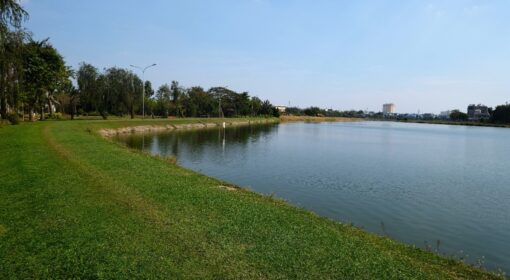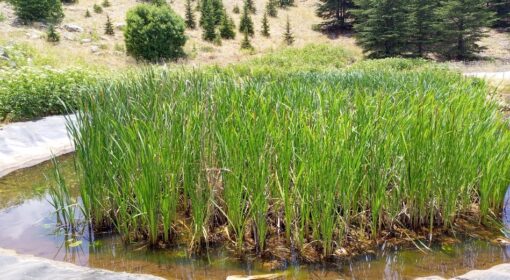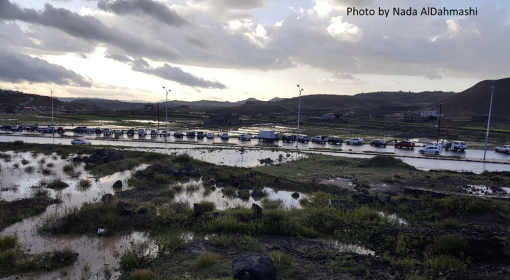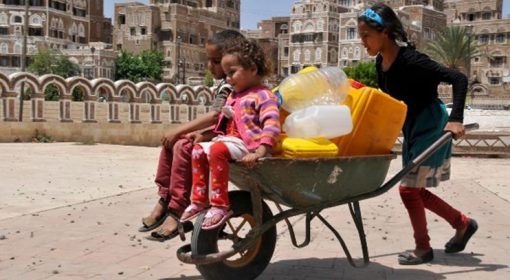Yemen: poor sanitation infrastructure in times of war
by Nada al Dahmashi :: August 09, 2019
It is well-known that war can only result in destruction and devastation. In a country that is already grieving from weak infrastructure, it was clear that war will aggravate hunger, diseases, and the need for fundamental services.
The sanitation networks in Yemen weren’t sufficient even before the war People were used to see some sewage overflowing in their neighborhoods, especially during the rainy season. In Sana’a, for example, there isn’t a sewage network that covers the whole city. Some neighborhoods still have cesspits. Even while implementing Sana’a wastewater treatment plant, it was known its capacity wasn’t enough for all Sana’a’s swage at that time. Its 50000 m3 capacity, is inadequate nowadays and was inadequate back then. And it is now working with load bigger than what it was designed for.
The water being expelled from the treatment. Photographs by Osama al Jailani (left) and Nada al Dahmashi (right)
The design was developed in the eighties. The implementation did not start until much later, in the nineties. However, the design remained unchanged. Meanwhile, the population grew and continues to do so. The outcome is a treatment plant that churns out water with a Biochemical Oxygen Demand (BOD) higher than 500 mg/L, which cannot be used to irrigate.
Nevertheless, farmers do irrigate with it. This started when this water first leaked into some farmers’ fields and they noticed a higher yield as a result. They then started using this water and keeping water from wells for their own use. The government tried to deter this behavior, using several measures, but to no avail. Thus, Sanaá residents continued to be supplied with vegetables and fruits that are contaminated.
The vegetables and a canal carrying the contaminated water. (Bottom right) Livestock drinking the untreated water and eating the grass grown by it.
Generators being used to pump the contaminated water onto the fields
In times of war, many sanitation facilities were destroyed and the treatment plant was out of service for a while. So the farmers have been using the expelled water without any treatment.
Such use of untreated wastewater has been a big concern for government authorities and INGOs alike. Several diseases have spread due to lack of awareness of such practices, such as cholera of which the city has seen several outbreaks during summers and the rainy season. Many awareness campaigns to promote hygienic habits have been carried out among farmers and the public.
Hayel Street As A Miserable Example of Sana’a City:
The congested Hayel street, in the heart of Sana’a, is a commercial centre. it is one of the areas that lack basic infrastructure. During the war, this neighborhood has recorded one of highest records in receiving the Internally Displaced People (IDPs). This has only worsened its situation. As someone living in that very area, I have experienced sewerage spilling on to the street millions of times over the past five years. Due to the current economic situation many government employees haven’t received salaries for three years, the cleaning workers have been on strike many times.
Garbage piles up quickly on Hayel Street since located here are several markers, malls, hotels, and fuel stations. The garbage often clogs the sewage disposal and storm drains. Of late, residents in Hayel street have complained of traces of sewage in the water supplied to them by the Sana’a Water and Sanitation Local Corporation (the water provider to the public).
The sewerage network in this area is half new and half very old. Contamination has happened in parts of the old network. Presumably the water and sewerage pipes have broken and their contents have mixed. Stumped by the foul smell, a lot of people have been running the water out on the streets, and bought water from tankers instead.
Residents run the contaminated water supplied to their taps onto Heyal street
A recent facebook post by the Social Fund for Development asks residents to suggest solutions. Many have suggested that garbage should not be allowed to accumulate, that water and sanitation lines should be maintained more frequently, and that the storm drains should be fixed.
New Projects in Sana’a Towards Sanitation Improvements
Due to the war, understandably, there has been emphasis on emergency response across the country. The main focus was, and continues to be, on providing water and food. There has been widespread ignorance regarding the importance of sanitation. Of late, the WaSH Cluster and NGOs working in the field have been trying to incorporate sanitation more and more in their projects, budgets, and future agenda.
Opening of the FAO project (Photo by Osama al Jailani)
FAO has implemented a new small project in partnership with water user associations (WUAs) in the Sanaá basin, such as the Al Ahdaq WUA located close to the wastewater treatment plant, where farmers have been using the untreated water expelled from the plant. As part of the project, FAO is installing in the area small units that are more like sceptic tanks than treatment plants. Will such units bring about significant change? Only time will tell. However, as an engineer, I doubt that these units will be very effective in curbing the problem. Nevertheless, the project has pushed sanitation higher up NGO agenda. As more organisations follow suit, many diseases will be prevented and people’s livelihoods will improve. Side-by-side, in this water scarce country, treated wastewater should be utilized much more as an alternative to fresh groundwater, to save groundwater sources from exploitation.
Units being constructed under the FAO project
{jcomments on}










